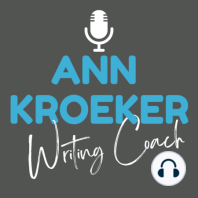6 min listen

Try This Classic Structure for Your Next Nonfiction Writing Project
Try This Classic Structure for Your Next Nonfiction Writing Project
ratings:
Length:
15 minutes
Released:
Nov 6, 2019
Format:
Podcast episode
Description
Organization is a challenge for writers. You may have strong ideas, feel confident with grammar, and write in a fun style.
But putting it all together in a structure that makes sense? That can be hard.
There’s no one perfect way to structure most projects. You have options.
Some people find this liberating. They enjoy exploring countless options and settle naturally into an order that makes sense for their content.
Other writers find this overwhelming. They’d like to be told, "If you’re writing THIS, you always use THAT structure."
Without structure, those writers get stuck.
Structure Brings Order and Clarity
In fact, I’ve met with writers who have been stuck for weeks, months...occasionally for years. All because they didn’t know how to structure their project.
Without structure, they didn’t know how to order and organize their ideas, so writing itself felt confusing. They simply shoved it aside, unclear what to do next.
Structure brings order and clarity to the writer.
And structure brings order and clarity to the reader.
Structure for Poets
Some writing offers built-in structure.
If you’re a poet, for example, you can turn to form poetry to find structure built into the assignment. So many kinds of poems follow a form or a pattern, like a sestina, sonnet, and a rondelet. They each come with rules, rhythms, and rhyme schemes. While challenging, these limits offer structure that a poet who works in free verse lacks.
Structure for Novelists
Novelists can turn to structure that works well for fiction, such as the hero’s journey. The author doesn’t have to include the obligatory scenes, but many genres work well when the author hits those beats, moments, or scenes a reader has come to expect.
Structure for Nonfiction Writers
Nonfiction writers may face the blank page with no idea where to start. Or they spit out their ideas with no clue how to arrange them to create an order that flows well for the reader.
Writers who compose essays, articles, books know they have a problem to solve: they need structure.
And they may struggle with structure due to lack of resources. Maybe no one has pointed out to them structure options. Or maybe they struggle to remain objective with their own material to see how it would best flow.
They may have tried methods they’ve learned over the years and those have gotten them only so far.
Mind Maps Don't Automatically Lead to Structure
For instance, maybe they tried a mind map. And that helped them spit out the main ideas they want to cover in their book. But all those circles spread out like a web on the paper don’t themselves reveal a solid structure—they just reveal a number of possible starting points and all their subpoints. So the mind map may have served to pull out of the writer content ideas, but the map itself didn’t result in a clear structure.
Traditional Outlines Don't Automatically Lead to Structure
The writer of nonfiction may have reverted to the I, II, III, and A, B, C format they remembered from their youth, with those Roman numerals leading the eye down the page with indented A, B, C items underneath. Under those lines came the numbers 1, 2, 3, then lowercase a, b, c, followed by the little “i’s” with one “i” then two “ii’s” and “iii’s” that created those miniature Roman numerals, leading up to “iv’s” and “v’s.”
The poor writer may spend more time fretting over those little “i’s” than they do crafting content. So knowing how to type up a list with Roman numerals again doesn’t in and of itself reveal a structure.
Even organized, sequential-types who love to line up papers and numbers and files and books on shelves can create a perfectly reasonable classic outline, yet find themselves unsure if that’s formed an effective structure for their writing project.
Try Ready-Made Outlines to Structure Your Next Project
How can writers who struggle to organize their ideas find a structure that works?
Released:
Nov 6, 2019
Format:
Podcast episode
Titles in the series (100)
#43: How to Avoid Distraction and Manage Attention to Write: Show Notes - Episode #43: How to Avoid Distraction and Manage Attention to Write - In this episode, I take both a macro and micro view of attention, focus, and distraction. - At the macro level, I suggest that formulating a general plan of where yo... by Ann Kroeker, Writing Coach